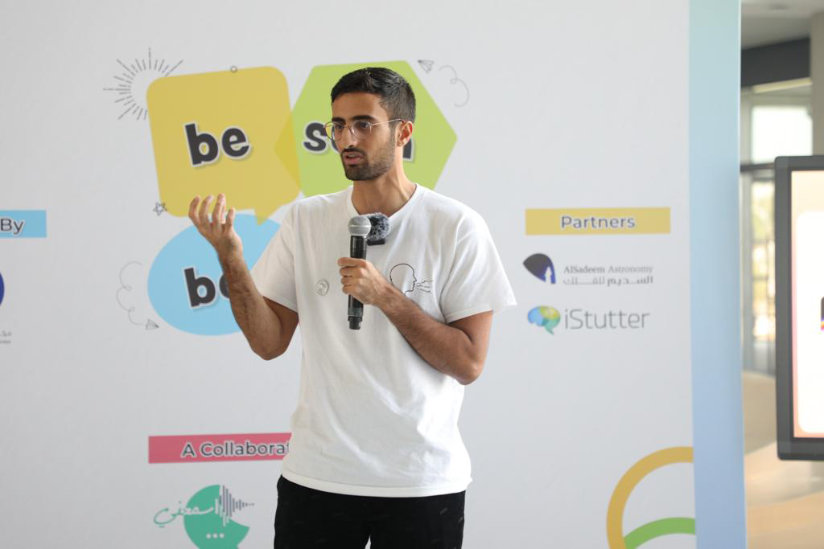RIYADH: Saad Al-Munajem recalls his early memory of stuttering as a first-grader — of reading in front of his classmates and the entire class bursting out laughing.
Al-Munajem struggled for years to conceal his stuttering, feeling guilty and attempting to find a way out. He looked into various coping mechanisms and workarounds in an effort to fit in with a culture that values clear speech.
“I am 23-years-old, and (for) 19 years of my life, I hated showing that I stutter. When I am stuttering I feel stuck, the words can’t come out. I hated this whole situation,” Al-Munajem said.
Feeling the pressure to speak clearly creates a vicious cycle, he explained: “I pressure myself harder to get out of the situation, but the pressure makes the (stuttering) last longer … it is like a whirlpool of negative emotions.”
Acceptance was the only way out. It birthed the most honest version of Al-Munajem, a version that helped him to find his voice and purpose in life.
Today, Al-Munajem is the founder of Mutalaathem, an association that aims to raise awareness of stuttering and support those who stutter and their families.

The advocate for stuttering is a racer, a karting lover and an adventurer. (Supplied)
Mutalaathem was established in October 2021 around International Stuttering Awareness Day, which falls on Oct. 22 each year. The association organizes weekly gatherings, inviting people who stutter to further their sense of empowerment and confidence to communicate with others without avoidance.
In establishing Mutalaathem, Al-Munajem was greatly influenced by a therapy speech clinic he attended while he was studying political science in the US.
He had attended other therapy speech clinics before, but the strategies adopted by the university clinic were different and marked a turning point.
“I realized from attending the sessions at the therapy clinic at my university that the aim was to talk confidently and say what I want to say regardless of whether I stutter or not,” Al-Munajem said.
Following this mindset, Al-Munajem started to challenge himself and talk to strangers and to say the three words that have haunted him: “I have stuttering.”
“From there I started talking about the emotions I felt when stuttering and realized that stuttering is not something to be ashamed of. I simply just needed more time to talk, reaching what’s called stuttering desensitization,” Al-Munajem said.

Almunajem is the founder of Mutalaathem, an association aimed to raise awareness of stuttering. (Supplied)
Once he reached stuttering desensitization, the speech therapy specialists at the clinic referred Al-Munajem to the university’s student club for people who stutter. “I went there and I was surrounded by stutterers, with each person having a different level of stuttering,” he said. “We all shared common feelings of what it is like to live as someone who stutters. They (became) like another family to me.”
After graduating and returning to Riyadh, Al-Munajem started Mutalaathem to raise awareness of stuttering in the Kingdom, so that the people like him know that they are not alone.
Al-Munajem and his organization became well-known when he shared a video of himself on TikTok ordering food from a KFC’s drive-thru.
“The video went viral, and I saw that the Mutalaathem Instagram account is getting more followers, people, and stutterers in the Kingdom who knew about me, and the initiative increased,” he said.
HIGHLIGHTS
International Stuttering Awareness Day falls on Oct. 22 each year.
Mutalaathem, founded by Saad Al-Munajem, aims to raise awareness of stuttering and support those who stutter and their families.
Al-Munajem categorizes society’s response to stuttering into two categories.
There are ignorant people, who think they are being funny by making fun of the way stutterers speak, and there are others who are aware of what stuttering is and want to help, but don’t know how, and often unknowingly end up making stutterers feel bad about themselves.
Finishing the sentence of a person who stutters, thinking that one is being helpful, can make a stutterer feel worse and can reduce their confidence.
“Some believe that stuttering comes out because I get nervous. It is true that being nervous makes me stutter more often, it is a factor, but it does not cause stuttering. I do still stutter in front of my close friends and family,” Al-Munajem said.
Through Mutalaathem, Al-Munajem is fighting misconceptions about stuttering and the nature of the condition, which has long been misunderstood by society.
Being open about stuttering has made Al-Munajem who he is today — a prominent advocate for stuttering in the Kingdom, a racer, a karting lover and an adventurer, with an important message to convey.
“To anyone who stutters or knows a stutterer, please reach out and I will help in every way possible. And to parents with a stuttering child, please allow the topic of stuttering to be open in the house. Don’t make it a taboo topic … that way a child becomes open and confident with their stuttering.”






























